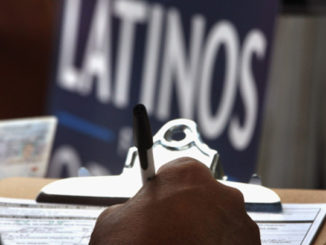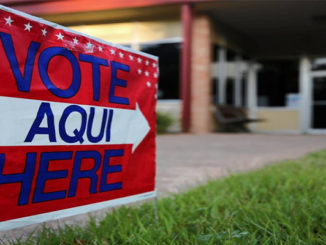
Republicans want to shrink government. But their core voters benefit from assistance, like the Supplemental Nutrition Assistance Program, the most.
by Ronald Brownstein
Even as congressional Republicans mobilize for a new drive to retrench federal anti-poverty efforts, whites without a college degree—the cornerstone of the modern GOP electoral coalition—have emerged as principal beneficiaries of those programs, according to a study released Thursday morning.
The Center on Budget and Policy Priorities, a liberal policy-analysis group, found that in both percentage terms and absolute numbers, federal programs reduced poverty among working-age whites without a college degree more than they did among non-college-educated Hispanics, African Americans, or members of other races, and far more than they did among college-educated adults of any race. The number of these working-age whites, in fact, exceeded the combined number of non-college-educated blacks, Hispanics, and members of other races that made such gains.
These findings, based on 2014 Census Bureau data, echo other studies showing that blue-collar whites have been among the principal beneficiaries of the Affordable Care Act. Both results underscore the challenge Republicans face reconciling their ideological determination to shrink the federal government with the practical needs of their increasingly working-class coalition.
Donald Trump, for instance, won about two-thirds of whites without a college degree—the most for any Republican since Ronald Reagan in his 1984 landslide—and they provided almost exactly half of his total votes, even though they represented only about one-third of the electorate, according to media exit polls. Similarly, 152 House Republicans, out of 241 total, represent heavily blue-collar districts where the white population exceeds the national average and the portion of those whites with at least a four-year degree lags below the national average. The GOP’s overwhelming advantage in those working-class districts underpins their House majority.
Using results from the Census Bureau’s Current Population Survey, with supplemental data from an Urban Institute analysis of transfer payments, the new CBPP study challenges the frequent assumption that government anti-poverty programs primarily benefit minority communities. Instead, by examining the experience of working-age adults ages 18 to 64, the study presents evidence that education levels, not race, are the key dividing line in the programs’ reach.“Safety-net programs are particularly beneficial for adults without a college degree,” wrote the study’s authors, Isaac Shapiro, Danilo Trisi, and Raheem Chaudhry. “The vast majority of working-age adults lifted above the poverty line by government benefits and tax credits are people lacking a college degree.”The study’s biggest surprise may be how many of those beneficiaries are the non-college-educated whites critical to GOP fortunes. The study found that without accounting for government benefits, the poverty rate stood at nearly 25 percent for working-age white adults in families where no one holds at least a four-year college degree. That represents 14.1 million people in all.
But after accounting for the impact of federal anti-poverty and income-support programs—including Social Security, the Supplemental Nutrition Assistance Program (known formerly as food stamps), Supplemental Security Income, Temporary Assistance for Needy Families (generally described as welfare), and the earned-income and children’s tax credits—6.2 million of those non-college-educated white adults were raised above the poverty line. That reduced their poverty rate to less than one in seven, and meant that government benefits lifted fully 44 percent of otherwise poor, non-college-educated whites above the poverty line.
African Americans, Hispanics, and members of other races without advanced degrees confronted even higher poverty rates than working-class whites. But they didn’t gain quite as much from the federal anti-poverty programs. Although the CBPP analysts have not fully isolated the cause of that disparity, they say one factor may be the important role of Social Security in lifting people from poverty. That benefits whites most because they comprise the vast majority of today’s older Americans.
African Americans gained more from federal programs than other non-whites did. The study found that 43 percent of non-college-educated African Americans—some 6.5 million people in all—fell below the poverty line before accounting for government supports. Those programs lifted 2.8 million of those working-class black adults above the poverty line, which lowered their poverty rate to just under one in four. That represented a 43 percent reduction in the number of poor, working-class African Americans, a figure comparable to the percentage (if not absolute) gains among whites.Among Hispanics, the study found, 8.6 million adults without advanced degrees fell below the poverty line, some 36 percent of that total population. Federal programs reduced that number by 2.4 million, or 28 percent, to a level just above one-fourth. Among members of other races, 2 million of those without degrees, or about one-third of the population, lived in poverty before accounting for government programs; those programs reduced their numbers by 700,000, or 37 percent, to a level just above one-fifth.
Escaping Poverty
Adults from all races who hold at least a four-year college degree are much less likely to be poor: Just 6.7 million, or under 9 percent, are. Government programs reduced the number of college-educated adults from any race in poverty by 1.8 million, or 27 percent. Fewer than one in 16 of them remained poor after accounting for the government supports.
These national trends are especially concentrated in the region that proved decisive in the 2016 election. A recent Urban Institute study found that whites without a college degree constituted a majority of those who gained coverage under the ACA in the five Rustbelt states that Trump flipped from blue to red: Iowa, Ohio, Michigan, Wisconsin, and Pennsylvania. Similarly, the CBPP found that among all adults lifted out of poverty by federal programs, whites without a college degree represented 77 percent in Iowa, 64 percent in Ohio, 61 percent in Pennsylvania, 59 percent in Michigan, and 51 percent in Wisconsin.
House Republicans have repeatedly passed budgets that impose significant reductions on government anti-poverty programs, but those plans were mostly stymied in the Senate or by former President Obama. Now, with unified control of Washington, the GOP has a much clearer path toward enacting those cuts. But, as with the drive to repeal the ACA, they face the risk of withdrawing government benefits that many of their own voters rely on.
“[T]he election has brought increased attention to the economic difficulties that people without a college degree can face,” the CBPP report’s authors write. “Largely overlooked in the discussion of these issues to date, however, is the fact that the nation’s poverty-reduction programs provide extensive support to adults lacking a college degree, including working-class whites, and that such people would be the principal losers under various proposals to cut these programs that may emerge in coming months.”
Ronald Brownstein is Atlantic Media’s editorial director for strategic partnerships



